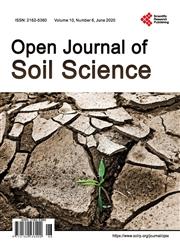Impact of MgCl2 Modified Biochar on Phosphorus and Nitrogen Fractions in Coastal Saline Soil
引用次数: 4
Abstract
Biochar application is claimed to improve nutrient availability in many problem soils; however, pristine biochars are often reported to produce inconsistent results. Therefore, appropriate biochar modification techniques are required to retain soil nutrients at an optimum level. To increase Nitrogen (N) and Phosphorus (P) availability in coastal saline soil, two slow pyrolyzed biochars viz domestic organic waste (DWB) and farmyard manure (FMB) were modified with MgCl2. Ten different treatments comprising the biochars (pristine and modified) with and without the recommended fertilizer were applied (2% w/w) to the soil and incubated for ninety days. The soils were analyzed for pH, EC, available , and different phosphorus fractions sequentially extracted by NH4Cl, NaHCO3, NaOH, and HCl. During the incubation period, biochar treatments increased all phosphorus and nitrogen fractions than the control and recommended fertilizer treatment. The application of FMB significantly (p 4Cl, NaHCO3, and NaOH extractable P fractions from DWB, while HCl soluble fraction was enhanced (p > 0.05) by DWB. The increased Al and/or Fe bound phosphate after 60 days of incubation had significant correlations to decreasing soil pH and NaHCO3-P, indicating reduced availability with time. Further Mg modification slightly increased P availability only after 60 days of incubation. The modification also improved both nitrogen fractions but significantly (p 3-N content which could be the result of electrostatic attraction between Mg2+ and ions. Overall, Mg-modified biochar may retain both phosphates and nitrates in soil. However, the magnitude of retention will vary depending on biochar type, nutrient species, and aging in soil.MgCl2改性生物炭对滨海盐渍土磷、氮组分的影响
据称,施用生物炭可以提高许多问题土壤的养分有效性;然而,据报道,原始生物炭往往产生不一致的结果。因此,需要适当的生物炭改性技术来将土壤养分保持在最佳水平。为了提高滨海盐渍土中氮(N)和磷(P)的有效性,用MgCl2对两种缓慢热解的生物炭,即生活有机垃圾(DWB)和农家肥(FMB)进行了改性。将10种不同的处理方法,包括添加和不添加推荐肥料的生物炭(原始和改性)(2%w/w)施用到土壤中,并孵育90天。分析土壤的pH值、EC、有效磷和不同磷组分,依次用NH4Cl、NaHCO3、NaOH和HCl提取。在孵化期,生物炭处理比对照和推荐的肥料处理增加了所有磷和氮组分。FMB的应用显著(P4Cl、NaHCO3和NaOH可从DWB中提取的p组分,而HCl可溶性组分的应用则因DWB而增强(p>0.05)。培养60天后,Al和/或Fe结合磷酸盐的增加与土壤pH和NaHCO3-P的降低显著相关,表明有效性随着时间的推移而降低。只有在培养60天后,进一步的Mg修饰才略微增加了P的可用性。改性还改善了两种氮组分,但显著提高了(p3-N含量,这可能是Mg2+和离子之间静电吸引的结果。总体而言,Mg改性的生物炭可以在土壤中保留磷酸盐和硝酸盐。然而,保留的程度将因生物炭类型、营养物质和土壤老化而变化。
本文章由计算机程序翻译,如有差异,请以英文原文为准。
求助全文
约1分钟内获得全文
求助全文

 求助内容:
求助内容: 应助结果提醒方式:
应助结果提醒方式:


